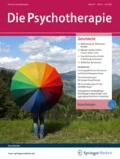Zusammenfassung
Ausgehend von Bindungsstilen als umschriebenen Mustern der Wahrnehmung, des Denkens, Fühlens, der Erwartungen und der Handlungsbereitschaften in bindungsrelevanten Situationen (Bowlby 1975; Ainsworth et al. 1978; Main 1990) war es Ziel, diese Muster im Sinne ihrer ursprünglichen Definition angemessen, d.h. als spezifische Merkmalskonfigurationen zu operationalisieren. Beschreibungen der drei Bindungsstile „sicher”, „vermeidend” und „ambivalent” wurden übersetzt in Selbstbeschreibungen von Klienten zu Beginn einer therapeutischen Beziehung. Anhand faktorenanalytischer Ergebnisse wurden drei Skalen gebildet: „Akzeptanzprobleme”, „Öffnungsbereitschaft” und „Zuwendungsbedürfnis”. 374 stationäre Patienten (56,3% weiblich, 43,7% männlich) füllten zu Beginn ihrer Psychotherapie den BFKE aus. Die Clusteranalyse ergab fünf Cluster, die als Bindungsstile interpretiert werden können: „sicher”, zwei Varianten von „unsicher-ambivalent” („verschlossen” und „anklammernd”) und zwei Varianten von „unsicher-vermeidend” („verschlossen” und „kooperationsbereit”). Die Diskriminanzanalyse dieser Cluster ergab Diskriminanzfunktionen, die denen von Collins u. Read (1990) sowie Ainsworth et al. (1978) entsprechen.
Summary
According to the concept of attachment styles as distinct adaptive patterns of perceptions, thoughts, feelings, expectations and action tendencies in attachment-relevant situations (Bowlby 1975; Ainsworth et al. 1978; Main 1990), we tried to portray these patterns in adequate operationalisations i.e. as distinguished configurations of personal characteristics. Descriptions of each of the three attachment styles „secure”, „avoidant” and „ambivalent” were translated into terms of self-descriptions given by clients imagining their future psychotherapeutic relationship. Following the results of factor analysis three scales were constructed: „problems in feeling accepted”, „readiness for self-disclosure” and „need for care”. N=374 inpatients (56,3% female, 43,7% male) at the beginning of psychotherapy completed the BFKE. Cluster analysis resulted in five clusters, which can be interpreted as attachment styles: „secure”, two subgroups of the „ambivalent” („withdrawing” and „clinging”) and two subgroups of the „avoidant” style („withdrawing” and „cooperative”). Discriminant analysis of the clusters led to discriminant functions corresponding with the results of Collins and Read (1990) and Ainsworth et al. (1978).
Author information
Authors and Affiliations
Rights and permissions
About this article
Cite this article
Höger, D. Der Bielefelder Fragebogen zu Klientenerwartungen (BFKE) . Psychotherapeut 44, 159–166 (1999). https://doi.org/10.1007/s002780050161
Issue Date:
DOI: https://doi.org/10.1007/s002780050161

